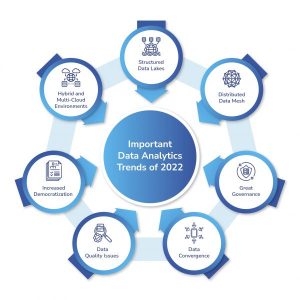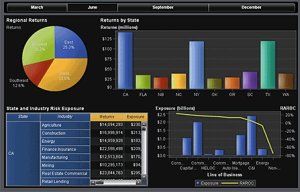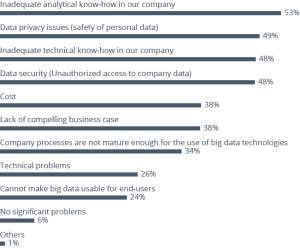
Data analysis is an ever-evolving field that continues to transform industries and drive innovation. As technology advances, new trends are emerging that promise to reshape how businesses and organizations analyze and utilize data. In this blog, we will explore some of the most significant trends in data analysis that are shaping the future.
1. Artificial Intelligence and Machine Learning
Artificial intelligence (AI) and machine learning (ML) are at the forefront of data analysis advancements. These technologies enable the automation of complex data tasks and the generation of insights that were previously unattainable.
Key Developments:
- Automated Machine Learning (AutoML): Tools that automate the end-to-end process of applying machine learning to real-world problems, making it more accessible to non-experts.
- Natural Language Processing (NLP): Enhancing the ability to analyze unstructured text data and extract meaningful insights.
- Deep Learning: Improving the accuracy and capabilities of predictive models in areas such as image recognition, speech analysis, and autonomous systems.
Impact:
- Enhanced decision-making with more accurate predictions and insights.
- Reduction in the time and resources required for data analysis.
- Greater accessibility of advanced analytics to a broader range of users.
2. Big Data and Real-Time Analytics
The volume of data generated globally is growing exponentially, leading to the need for big data technologies and real-time analytics.
Key Developments:
- Stream Processing: Technologies like Apache Kafka and Apache Flink enable the processing and analysis of data streams in real-time.
- Edge Computing: Processing data closer to the source (e.g., IoT devices) to reduce latency and bandwidth usage.
- Scalable Storage Solutions: Advances in cloud storage and distributed databases to handle massive datasets efficiently.
Impact:
- Faster decision-making with real-time insights.
- Improved operational efficiency and responsiveness.
- Enhanced ability to detect and react to anomalies and trends as they occur.
3. Data Democratization
Data democratization involves making data and analytics accessible to a wider range of users within an organization, regardless of their technical expertise.
Key Developments:
- Self-Service Analytics Tools: User-friendly platforms like Tableau, Power BI, and Qlik that allow non-technical users to create reports and dashboards.
- Data Literacy Programs: Training initiatives to improve data literacy across organizations.
- Collaborative Analytics: Tools that enable collaborative data analysis and sharing of insights across teams.
Impact:
- Empowerment of employees to make data-driven decisions.
- Increased innovation and agility within organizations.
- Reduction in reliance on specialized data teams for everyday analytics tasks.
4. Data Privacy and Security
As data becomes more valuable, concerns about privacy and security are growing. Ensuring the protection of sensitive data is a top priority.
Key Developments:
- Data Anonymization and Encryption: Techniques to protect personal and sensitive information while maintaining data utility.
- Privacy Regulations: Compliance with regulations like GDPR, CCPA, and other emerging privacy laws.
- Secure Data Sharing: Solutions for secure data sharing and collaboration, such as differential privacy and federated learning.
Impact:
- Increased trust in data practices and analytics processes.
- Enhanced protection of sensitive information.
- Greater compliance with legal and regulatory requirements.
5. Advanced Data Visualization
Data visualization is evolving to provide more intuitive and interactive ways to explore and interpret data.
Key Developments:
- Augmented Analytics: Integrating AI and ML into data visualization tools to provide automated insights and recommendations.
- Immersive Visualization: Use of virtual reality (VR) and augmented reality (AR) to create immersive data exploration experiences.
- Storytelling with Data: Enhancing data presentations with narrative techniques to communicate insights more effectively.
Impact:
- Improved understanding and communication of data insights.
- Enhanced ability to identify patterns and trends through interactive visuals.
- More engaging and impactful data presentations.
6. Ethical AI and Responsible Data Use
As AI and data analysis become more pervasive, ensuring ethical and responsible use of data is critical.
Key Developments:
- Bias Detection and Mitigation: Tools and techniques to identify and reduce bias in AI models and data analysis processes.
- Transparency and Explainability: Methods to make AI models and their decisions more transparent and understandable.
- Ethical Frameworks: Development of guidelines and best practices for ethical AI and data use.
Impact:
- Fairer and more equitable data analysis and AI applications.
- Increased transparency and accountability in decision-making processes.
- Greater public trust in data-driven technologies.
7. Integration of IoT and Data Analysis
The Internet of Things (IoT) is generating vast amounts of data from connected devices, which can be harnessed for advanced analytics.
Key Developments:
- Sensor Data Analysis: Techniques for analyzing data from sensors and connected devices to gain insights into physical environments.
- Predictive Maintenance: Using IoT data to predict equipment failures and optimize maintenance schedules.
- Smart Cities: Leveraging IoT data to improve urban planning, traffic management, and public services.
Impact:
- Enhanced operational efficiency and cost savings.
- Improved maintenance and asset management.
- Smarter and more sustainable urban environments.
Conclusion
The future of data analysis is bright, with numerous trends poised to transform how businesses and organizations leverage data. From AI and real-time analytics to data democratization and ethical AI, these developments are driving innovation and creating new opportunities for growth. By staying informed about these trends and adopting the latest technologies, companies can harness the full potential of data analysis to achieve their strategic objectives and stay ahead in the competitive landscape.
As we move forward, the ability to analyze and interpret data will continue to be a key differentiator for businesses, enabling them to make informed decisions, optimize operations, and deliver value to their customers. Embracing these trends and investing in data analytics capabilities will be essential for success in the data-driven future.








